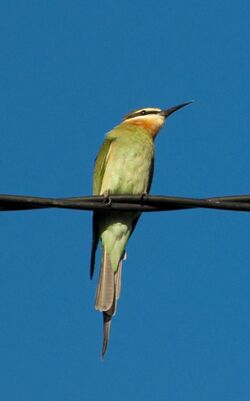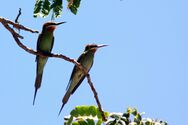Biology:Olive bee-eater
| Olive bee-eater | |
|---|---|

| |
| Scientific classification | |
| Domain: | Eukaryota |
| Kingdom: | Animalia |
| Phylum: | Chordata |
| Class: | Aves |
| Order: | Coraciiformes |
| Family: | Meropidae |
| Genus: | Merops |
| Species: | M. superciliosus
|
| Binomial name | |
| Merops superciliosus Linnaeus, 1766
| |
The olive bee-eater or Madagascar bee-eater (Merops superciliosus) is a near passerine bee-eater species in the genus Merops. It is native to the southern half of Africa where it is present in Angola; Botswana; Burundi; Comoros; Democratic Republic of the Congo; Djibouti; Eritrea; Ethiopia; Kenya; Madagascar ; Malawi; Mayotte; Mozambique; Namibia; Rwanda; Somalia; South Sudan; Sudan; Tanzania; Uganda; Zambia; Zimbabwe. It is a common species with a wide range so the International Union for Conservation of Nature has rated their conservation status as "least concern".[1]
Taxonomy
In 1760 the French zoologist Mathurin Jacques Brisson included a description of the olive bee-eater in his Ornithologie based on a specimen collected on the island of Madagascar . He used the French name Le guespier de Madagascar and the Latin Apiaster Madagascariensis.[2] Although Brisson coined Latin names, these do not conform to the binomial system and are not recognised by the International Commission on Zoological Nomenclature.[3] When in 1766 the Swedish naturalist Carl Linnaeus updated his Systema Naturae for the twelfth edition, he added 240 species that had been previously described by Brisson.[3] One of these was the olive bee-eater. Linnaeus included a brief description, coined the current binomial name Merops superciliosus and cited Brisson's work.[4] The specific name superciliosus is Latin for "supercilious", "haughty" or "eye-browed".[5]
Two subspecies are recognised:[6]
- M. s. superciliosus Linnaeus, 1766 – east Africa, Madagascar and the Comoro Islands
- M. s. alternans Clancey, 1971 – west Angola and northwest Namibia
Description
The olive bee-eater grows to a length of 23 to 26 cm (9.1 to 10.2 in) with its tail streamers adding up to 7 cm (2.8 in). The sexes are similar, and adults have bronzy-green plumage with an olive cap and white forehead, eyebrows, chin and cheeks. The rump and tail are blue, apart from the streamers, which are black.[7]
Distribution
The olive bee-eater is found in the grassland and coastal mountain forests of East Africa and Madagascar , and an isolated population can be found in coastal Angola.[8] There are two subspecies; M. s. superciliosus occurs in eastern Ethiopia, Somalia and Kenya, and southwards through East Africa to southern Mozambique and the Zambezi Valley, as well as the Comoro Islands and Madagascar ; M. s. alternans occurs in western Angola and northwestern Namibia.[9]
Ecology
They are partially migratory, and usually breed only in the southern portion of their range, moving north for the dry season in southern Africa. It lays four eggs in a burrow nest at the beginning of the southern African wet season, and the chicks usually hatch at the beginning of December.[10] Unlike most bee-eaters, the species does not practice cooperative breeding and post-fledging dependence is only around 19 days, which is typical of temperate zone passerines and about half that of most Meropidae species.[11]
Gallery
References
- ↑ Jump up to: 1.0 1.1 BirdLife International (2016). "Merops superciliosus". IUCN Red List of Threatened Species 2016: e.T22683744A92998077. doi:10.2305/IUCN.UK.2016-3.RLTS.T22683744A92998077.en. https://www.iucnredlist.org/species/22683744/92998077. Retrieved 12 November 2021.
- ↑ Brisson, Mathurin Jacques (1760) (in fr, la). Ornithologie, ou, Méthode contenant la division des oiseaux en ordres, sections, genres, especes & leurs variétés. 4. Paris: Jean-Baptiste Bauche. pp. 545–549, Plate 42 fig 1. https://biodiversitylibrary.org/page/36195756. The two stars (**) at the start of the section indicates that Brisson based his description on the examination of a specimen.
- ↑ Jump up to: 3.0 3.1 Allen, J.A. (1910). "Collation of Brisson's genera of birds with those of Linnaeus". Bulletin of the American Museum of Natural History 28: 317–335.
- ↑ Linnaeus, Carl (1766) (in la). Systema naturae : per regna tria natura, secundum classes, ordines, genera, species, cum characteribus, differentiis, synonymis, locis. 1, Part 1 (12th ed.). Holmiae (Stockholm): Laurentii Salvii. p. 183. https://biodiversitylibrary.org/page/42946379.
- ↑ Jobling, J.A. (2018). "Key to Scientific Names in Ornithology". in del Hoyo, J.; Elliott, A.; Sargatal, J. et al.. Handbook of the Birds of the World Alive. Lynx Edicions. https://www.hbw.com/dictionary/definition/superciliosa-superciliosum-superciliosus.
- ↑ Gill, Frank; Donsker, David, eds (2018). "Todies, motmots, bee-eaters, hoopoes, wood hoopoes, hornbills". World Bird List Version 8.2. International Ornithologists' Union. http://www.worldbirdnames.org/bow/todies/.
- ↑ Fry, C. Hilary; Fry, Kathie (2010). Kingfishers, Bee-eaters and Rollers. Bloomsbury Publishing. pp. 273. ISBN 978-1-4081-3525-9. https://books.google.com/books?id=U_XUBAAAQBAJ&pg=PA273.
- ↑ "Range map". IUCN. http://maps.iucnredlist.org/map.html?id=106001178.
- ↑ Fry, H.; Boesman, P. (2016). "Olive Bee-eater (Merops superciliosus)". Handbook of the Birds of the World Alive. Lynx Edicions, Barcelona. http://www.hbw.com/node/55845.
- ↑ "Madagascar Bee-eater, Olive Bee-eater". Biodiversity Explorer. Iziko. http://www.biodiversityexplorer.org/birds/meropidae/merops_superciliosus.htm.
- ↑ Langen, Tom A. (2000). "Prolonged offspring dependence and cooperative breeding in birds". Behavioral Ecology 11 (4): 367–377. doi:10.1093/beheco/11.4.367.
External links
- Olive bee-eater - Species text in The Atlas of Southern African Birds.
Wikidata ☰ Q738736 entry
 |





